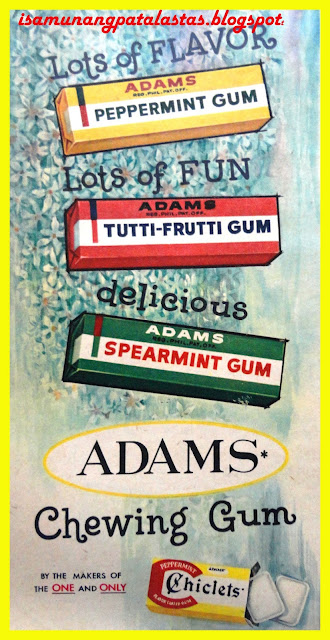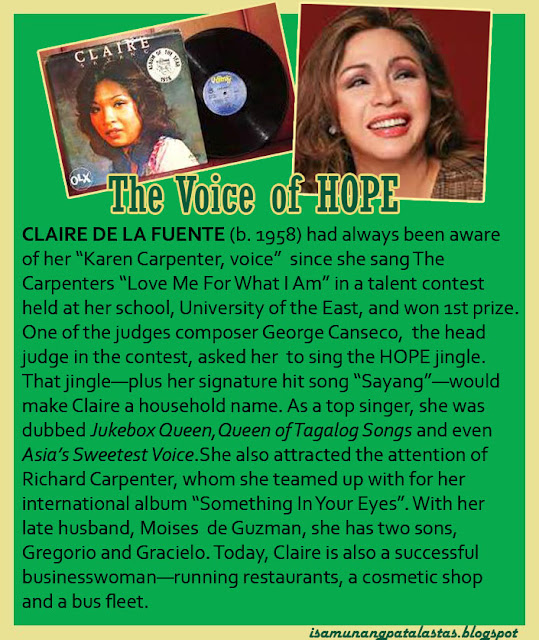 |
| COSMOS 1963 print ad. At its peak, it was the no. 1 sarsaparilla soda in the market. |
One of the more popular alternative soda brands in the
Philippines after the war was a product of the Manila Aerated Water Factory,
located on Misericordia St., Manila. It was founded way back in 1918 by Wong
Ning, a Guangdong native who migrated to the Philippines. He would be arrested
and jailed by the Japanese during World War II for his association with the
Kuomintang government, where he would tragically die in prison.
 |
| VERY EARLY COSMOS AD. 1955. Only 5 centavos per bottle! |
The eldest of his 7 children—Henry Gao-Hong Wong—rebuilt
the business post-war and renamed it in 1945 as COSMOS Bottling Corporation.
| THE BEST SARSAPARILLA! |
Its main product was a flavored beverage
called COSMOS Sarsaparilla. Sarsaparilla—similar to root beer—is made from the roots of the
sarsaparilla vine, and is considered as a tonic drink with medicinal value. The
flavor is not alien to Filipinos, as root beer was introduced by Americans in their regime;
Royal, and early soda brand, carried the same flavor.
| 'SARSI' IS COSMOS. This 1968 ad calls the sarsaparilla drink--Sarsi! |
Print advertising was begun in the mid 1950s. Soon,
COSMOS found its way to Filipino homes and became quickly a favorite, holding
its own against leaders Pepsi and Coca-Cola. The company, would prosper under the
management of the Philippine-educated
Henry, who was armed with a doctoral degree in Economics from the University of
Santo Tomas. COSMOS Bottling Corp,,under his helm, became the second largest
manufacturer of soft drinks in the Philippines.
 |
| SARSI AD, Featuring the 1968 Miss Asia, Macy Shih, and her court, ca. 1969 |
This paved the way for the Wong family to put up the
COSMOS Aerated Water in Hong Kong in 1947, with its own plant on Castle Peak
Road. COSMOS, too, became a favorite
brand, and soon, they expanded their plant and equipped it with
state-of-the-art bottling machines that could produce 3,000 bottled Cosmos per
hour, in Sarsaparilla, Orange, Cream Soda, Lime, Lemon, Mulberry, Grape and
Pineapple flavors. The Hong Kong operation was taken care of by younger brother
Hubert and Freddy Wong. After 1966, the COSMOS Hong Kong business seemed to
have faltered, although its corporate registration is still active today.
 |
| SARSI AD. With Miss Asia 1969, Wong Kyung Suh of Korea as endorser, |
 |
| THE SARSI SOCIETY, With Miss Asia '69 and her court. ca. 1970. |
The sarsaparilla flavor of COSMOS was such in demand by
the late 1960s, and consumers by then had started calling it “Sarsi”—and so the
name stuck, even though the bottles still bannered the COSMOS name up front.
COSMOS in orange flavor was relaunched in the early 70s as SUNTA.
 |
| CHRISTMAS AD, With the 1969 Miss Asia. ca. 1969 |
 |
| LET'S SARSI TOGETHER! With India's Zeenat Amman, Miss Asia '70. |
By a cruel twist of fate, the brilliant Henry--only 53--
died of a stroke caused by his brain
tumor in 1970. Several family members were unprepared to fill in the leadership
vacuum left by the patriarch, as there was no training for succession.
 |
| THE SARSI SOCIETY, With Carolyn Masibay, Mutya ng Pilipinas 1971. |
Still, advertising and promotions continued through the
1970s, with colored ads featuring Miss Asia and Mutya winners (COSMOS was into events marketing; it was a
major sponsor of Miss Asia and Mutya ng
Pilipinas). One of its most memorable commercials was the “SARSI with Egg” TVC
presented by imported talent Danny Vanni, who endorsed an unconventional usage
for drinking Sarsi—with a raw egg stirred in, yolks and all. Such a combination
supposedly ensured heightened energy.
 |
| THE SARSI SOCIETY. ca. 1971. |
The business floundered until, in RFM Corporation
acquired it from the Wong Family in 1989, thus ending the Wong family’s hold on
COSMOS which they have had for 7 decades. The products were briefly revitalized
by a new “Bagong Tunog” (all-Philippine music) campaign conceptualized by Basic
Advertising.
 |
| GET IT TOGETHER WITH SARSI. Print Ad. ca. 1974. |
In 2001, Coca-Cola Bottlers Phils. (under the combined
control of San Miguel and Coca-Cola Company) would acquire 83% of COSMOS Bottling from RFM, to give it ownership of 90% market share of the Philippine soft
drink market in the Philippines. It was delisted from the Philippine Stock
Exchange in 2013.
 |
| PSST. PASS IT ON! Sarsi Print Ad, 1975. |
At its peak, COSMOS Bottling Corp., were the makers of
Sarsi (Sarsaparilla), Sunta (Cosmos Orange Flavor), Sarsi Light, Pop Cola, Cheers Lemon and Orange, Jaz Cola
and Sparkle.
 |
| COSMOS PRODUCTS RELAUNCH. by Basic/FCB Advertising. 1989. |
SOURCES:
Cosmos Aerated Water – in Hong Kong from 1947
“The Fall of the Once Mighty Cosmos Soft drink Company”. https://www.pressreader.com/philippines/panay-news/20160720/281990376871997










